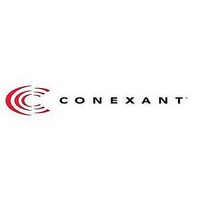bt8375kpf Conexant Systems, Inc., bt8375kpf Datasheet - Page 24

bt8375kpf
Manufacturer Part Number
bt8375kpf
Description
Single Chip Transceivers For T1/e1 And Integrated Service Digital Network Isdn Primary Rate Interfaces Systems
Manufacturer
Conexant Systems, Inc.
Datasheet
1.BT8375KPF.pdf
(323 pages)
Available stocks
Company
Part Number
Manufacturer
Quantity
Price
- Current page: 24 of 323
- Download datasheet (3Mb)
1.0 Pin Descriptions
1.1 Pin Assignments
Table 1-1. Hardware Signal Definitions (5 of 8)
1-8
TSBCKI
TPCMI
TSIGI
TINDO
TFSYNC
TMSYNC
Pin Label
TSB Clock Input
TSB Data Input
TSB Signaling Input
TSB Time Slot
Indicator
TSB Frame Sync
TSB Multiframe Sync
Signal Name
I
I
I
O
PIO
PIO
I/O
Transmit System Bus (TSB)
Serial data formatted into TSB frames consisting of DS0 channel time
Input or output TSB frame sync (see [TFSYNC_IO; addr 018]). TFSYNC
Input or output TSB multiframe sync (see [TMSYNC_IO; addr 018]).
Bit clock and I/O signal timing for TSB according to system bus mode (see
[SBI_CR; addr 0D0]). System chooses from 1 of four different clocks to
act as TSB clock source (see [CMUX; addr 01A]). Rising or falling edge
clocks are independently configurable for data signals TPCMI, TSIGI,
TINDO and sync signals TFSYNC and TMSYNC (see [TPCM_NEG and
TSYN_NEG; addr 0D4]). When configured to operate at twice the data rate,
TSB clock is internally divided by two before clocking TSB data signals.
slots and optional F-bits. One group of 24 T1 time slots or 32 E1 time slots
is selected from up to four available groups; data from the group is
sampled by TSBCKI, then sent towards transmitter output. Time slots are
routed through transmit slip buffer (see [TSLIPn; addr 140–17F])
according to TSLIP mode (see [TSBI; addr 0D4]). F-bits are taken from the
start of each TSB frame or from within an embedded time slot (see
[EMBED; addr 0D0]) and optionally inserted into the transmitter output
(see [TFRM; addr 072] register).
Serial data formatted into TSB frames containing ABCD signaling bits for
each system bus time slot. Four bits of TSIGI time slot carry signaling
state for each accompanying TPCMI time slot. Signaling state of every
time slot is sampled during first frame of the TSB multiframe, and then
transferred into transmit signaling buffer [TSIGn; addr 120–13F].
Active-high output pulse marks selective transmit system bus time slots
as programmed by SBCn [addr 0E0–0FF]. TINDO occurs on TSBCKI rising
or falling edges as selected by TPCM_NEG (see [TSBI; addr 0D4]).
output is active-high for 1 TSB clock cycle at programmed offset bit
location (see [TSYNC_BIT; addr 0D5]), marking offset bit position within
each TSB frame and repeating once every 125 s. When transmit framer is
also enabled, TSB timebase and TFSYNC output frame alignment are
established by transmit framer's examination of TPCMI serial data input.
When TFSYNC is programmed as an input, the low-to-high signal
transition is detected and aligns TSB timebase to programmed offset bit
value. TSB timebase flywheels at 125 s frame interval after the last
TFSYNC is applied.
TMSYNC output is active-high for 1 TSB clock cycle at programmed offset
bit location (see [TSYNC_BIT; addr 0D5]), marking offset bit position
within each TSB multiframe and repeating once every 6 ms coincident
with TFSYNC. When transmit framer is also enabled, TSB timebase and
TMSYNC output multiframe alignment are established by transmit
framer's examination of TPCMI serial data input. When TMSYNC is
programmed as an input, the low-to-high signal transition is detected and
aligns TSB timebase to the programmed offset bit value and first frame of
the multiframe. TSB timebase flywheels at 6 ms multiframe interval after
the last TMSYNC is applied. If system bus applies TMSYNC input, TFSYNC
input is not needed.
Conexant
Fully Integrated T1/E1 Framer and Line Interface
Definition
Bt8370/8375/8376
N8370DSE
Related parts for bt8375kpf
Image
Part Number
Description
Manufacturer
Datasheet
Request
R

Part Number:
Description:
Bluetooth RF Transceiver
Manufacturer:
Conexant Systems, Inc.
Datasheet:

Part Number:
Description:
Bluetooth RF Transceiver
Manufacturer:
Conexant Systems, Inc.
Datasheet:

Part Number:
Description:
ATM transmitter/receiver with UTOPIA interface
Manufacturer:
Conexant Systems, Inc.
Datasheet:

Part Number:
Description:
Service SAR controller
Manufacturer:
Conexant Systems, Inc.
Datasheet:

Part Number:
Description:
CN8223EPFATM Transmitter/Receiver with UTOPIA Interface
Manufacturer:
Conexant Systems, Inc.
Datasheet:

Part Number:
Description:
Embedded modem family
Manufacturer:
Conexant Systems, Inc.
Datasheet:

Part Number:
Description:
Fully integrated T1/E1 framer and line interface
Manufacturer:
Conexant Systems, Inc.
Datasheet:

Part Number:
Description:
Flicker-free video encoder
Manufacturer:
Conexant Systems, Inc.
Datasheet:

Part Number:
Description:
Home Networking Physical Layer Device with Integrated Analog Front End Circuitry Data Sheet (Preliminary) CX82100-41Home Network Processor (HNP)
Manufacturer:
Conexant Systems, Inc.
Datasheet:

Part Number:
Description:
Manufacturer:
Conexant Systems, Inc.
Datasheet:

Part Number:
Description:
Manufacturer:
Conexant Systems, Inc.
Datasheet:

Part Number:
Description:
Manufacturer:
Conexant Systems, Inc.
Datasheet:

Part Number:
Description:
Flicker-free video encoder
Manufacturer:
Conexant Systems, Inc.
Datasheet:

Part Number:
Description:
SmartV.XX Modem
Manufacturer:
Conexant Systems, Inc.
Datasheet:

Part Number:
Description:
Multichannel synchronous communications controller
Manufacturer:
Conexant Systems, Inc.
Datasheet:











